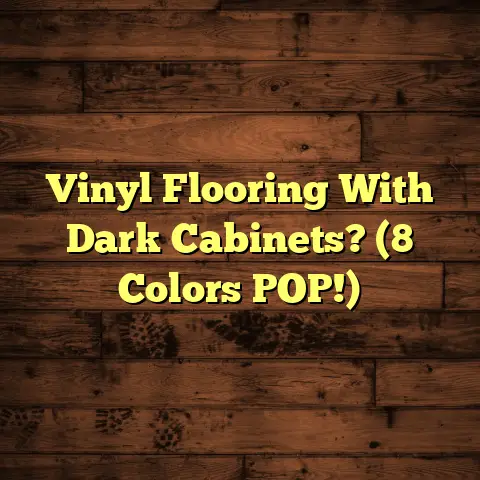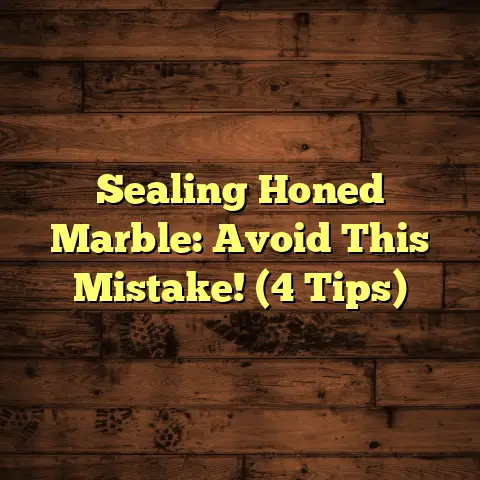How To Prevent Furniture From Moving On Hardwood Floors? (Explained)
I often find myself in conversations with clients about a common issue: furniture sliding on hardwood floors.
It’s frustrating, isn’t it?
You’ve just arranged your living room perfectly, and the next thing you know, your chair has drifted across the floor like it’s on a mission.
It can be annoying and even damaging to both your furniture and your beautiful hardwood.
Over the years, I’ve encountered this problem many times while working on various flooring projects.
Whether it’s a dining table that refuses to stay put during family meals or a couch that seems to have a mind of its own, I’ve learned effective strategies to keep furniture in its designated spot.
Let’s explore some practical solutions to prevent furniture from moving on hardwood floors, along with some personal insights and experiences along the way.
The Basics of Furniture Movement
When I first started in this industry, I didn’t realize how much the type of furniture and its legs could affect movement on hardwood surfaces.
For instance, certain materials, like plastic or metal, can easily slide over wood, while rubber or felt pads provide more grip.
Understanding these dynamics can be the first step toward a solution.
Soft vs. Hard Legs
One of my first challenges was dealing with dining chairs that had hard plastic legs.
They would glide effortlessly across the floor every time someone sat down, causing scratches and scuffs.
After trying various methods, I found that switching to chairs with rubberized legs helped significantly.
If you’re considering new furniture, look for options with soft feet or consider modifying your existing pieces.
Strategies to Prevent Movement
1. Use Furniture Pads
I can’t stress enough how effective furniture pads can be.
These little accessories come in various materials, including felt and rubber, and they can be placed under furniture legs to enhance grip and protect your floors.
Application Tips
- Measure the Legs: Ensure you choose pads that fit well under your furniture legs.
A snug fit is essential. - Regular Replacement: Over time, pads can wear out or lose their effectiveness.
I recommend checking them regularly and replacing them as needed.
2. Carpet Tiles or Area Rugs
Another great solution I’ve utilized is placing area rugs under furniture.
Not only do they add warmth and style to a room, but they also provide traction.
Selecting Rugs
- Size Matters: Make sure the rug is large enough to accommodate all furniture legs, creating a unified look.
- Material Choice: Opt for rugs with a non-slip backing to keep them in place.
3. Anti-Slip Coatings
For more permanent solutions, I’ve experimented with anti-slip coatings designed specifically for hardwood floors.
These products can create a textured surface that prevents sliding.
Application Process
- Surface Preparation: Clean the floor thoroughly before applying.
- Follow Instructions: Each product has specific instructions for application; adhering to these will yield the best results.
4. Weighing Down Furniture
An unconventional method I tried involved adding weight to lightweight furniture pieces.
For example, placing decorative stones or heavy books inside an open cabinet or console table can help keep it grounded.
5. Non-Slip Furniture Coasters
Another tool in my toolbox are non-slip coasters designed for furniture legs.
These coasters not only provide traction but also protect your floors from scratches.
Benefits of Non-Slip Coasters
- Easy to Apply: They come in various sizes and materials, making it simple to find the right fit for your furniture.
- Cost-Effective: Usually affordable, coasters can save you from costly floor repairs down the line.
Cost Considerations
When it comes to budgeting for these solutions, I often turn to FloorTally for accurate estimates of material costs.
It helps streamline my planning process and ensures I’m providing clients with realistic budgets.
For instance:
- Furniture Pads: Typically cost between $5 to $20 per set depending on quality and size.
- Area Rugs: Prices can vary from $50 to over $300 based on material and size.
- Anti-Slip Coatings: Generally range from $15 to $40 per bottle.
- Non-Slip Coasters: Usually priced around $10 to $30 for a set.
By using FloorTally, I can quickly input these costs and present clients with transparent estimates, which builds trust and helps them make informed decisions.
Challenges I’ve Encountered
While implementing these solutions has been largely successful, I’ve faced challenges along the way.
For example, not all furniture pads stick well over time, especially if they’re placed on uneven surfaces.
I’ve also discovered that some rugs can slide themselves if not secured properly.
In one project, my client loved a particular area rug, but it continuously slipped out of place under their coffee table.
We resolved this by using a combination of a rubberized rug pad beneath the rug and weighting down the corners with decorative objects.
Understanding the Furniture’s Environment
Another challenge I’ve encountered is the environmental factors that contribute to furniture movement.
For example, humidity and temperature changes can affect how slippery hardwood floors become.
In areas with high humidity, wood can expand slightly, creating a smoother surface that encourages sliding.
Tips for Addressing Environmental Factors
- Humidity Control: Use dehumidifiers in areas prone to excess moisture.
- Temperature Regulation: Maintaining a consistent temperature can also help reduce changes in wood behavior.
Comparing Different Approaches
Each method has its pros and cons:
Helpful Tips for Success
From my experiences, here are some tips that have worked well:
- Regular Maintenance: Check pads and rugs periodically for wear.
- Educate Clients: If you’re a contractor like me, ensure your clients understand the importance of these solutions.
- Mix and Match Solutions: Sometimes, combining methods provides the best results—like using both pads and rugs together.
- Test Before Committing: Always try out a solution in a small area first to see how it performs before applying it widely.
Personalized Anecdotes
I remember one project vividly where my client had just installed stunning hardwood floors in their newly built home.
They were thrilled until they realized their beautiful dining chairs kept sliding away from the table every time they sat down for dinner.
It became a running joke in their family until we stepped in with some solutions.
We started by installing high-quality felt pads under each chair leg.
Initially, they were skeptical about whether this would work, but within days they noticed a significant improvement.
Later on, we added an area rug under the dining table to anchor everything further.
The best part?
Not only did their dining experience improve, but their kids also loved having their own space without constantly pushing chairs back into place.
Seeing their happiness reminded me how small changes can make a big difference in everyday life.
Advanced Techniques for Persistent Problems
Sometimes, despite our best efforts, we encounter persistent problems with furniture movement.
In such cases, I’ve found that applying more advanced techniques can yield better results.
1. Heavy-Duty Adhesives
For furniture that absolutely refuses to stay put—like heavy cabinets or bookshelves—consider using heavy-duty adhesive pads or strips specifically designed for flooring applications.
These products provide a stronger bond than standard pads and can hold up against more substantial movements.
Application Tips
- Clean Surface Thoroughly: Ensure both the furniture leg and floor are clean before applying.
- Allow Proper Cure Time: Follow manufacturer instructions regarding cure time before placing weight on the furniture.
2. Custom Solutions
If you’re dealing with unique furniture shapes or sizes that traditional solutions don’t accommodate well, don’t hesitate to get creative!
For example, I once worked with an antique side table that had oddly shaped legs that wouldn’t fit standard pads.
To solve this issue, we crafted custom rubber footings that conformed perfectly to the legs’ shape.
Maintenance Practices for Long-Term Success
Implementing these solutions is just the beginning; maintaining them is equally important.
Here’s what I recommend:
Regular Inspections
Set aside time every few months to inspect all furniture pads and rugs for wear or damage.
This proactive approach helps catch problems before they escalate into bigger issues.
Cleaning Protocols
Regularly clean hardwood floors according to manufacturer guidelines.
Dust and debris can create added friction that may inadvertently contribute to movement issues.
Client Education
When working with clients, I always emphasize the importance of educating everyone in the household about how to care for their flooring and furnishings effectively.
Simple practices like lifting rather than dragging furniture can go a long way in preserving both floors and furniture during everyday activities.
Conclusion
Preventing furniture from moving on hardwood floors doesn’t have to be a daunting task.
By utilizing furniture pads, area rugs, anti-slip coatings, or simply weighing down lighter pieces, you can keep your space looking organized and avoid damaging your beautiful floors.
Reflecting on my journey as a flooring contractor, I’ve learned that no single solution fits all situations.
Each home is unique, so experimenting with different methods is key to finding what works best for you.
Whether you’re tackling this issue yourself or working with clients, these tips should help keep everything in place while enhancing the beauty of your hardwood floors.
In this ever-evolving industry, staying updated on new products and techniques is crucial for success.
Don’t hesitate to reach out to other professionals or join forums where you can share experiences and learn from others facing similar challenges.
Together, we can continue finding innovative ways to make our living spaces both functional and beautiful!





